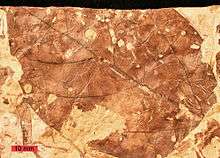Carbonaceous film
- For technology usage see carbon film

A carbonaceous film or carbon film is an organism outline of a fossil. It is a type of fossil found in any rock when organic material is compressed, leaving only a carbon residue or film.
When an organism is buried under many layers of sediment, pressure and heat increase during diagenesis and if the organism lacks a hard skeleton only leaving this thin film of carbon residue on rock surfaces.
The soft tissues of organisms are made largely of organic carbon compounds. Sometimes, fossils contain only carbon. Fossils usually form when sediment buries a dead organism. As sediment piles up, the organism's remains are subjected to pressure and heat. These conditions force gases and liquids from the body. A thin film of carbon residue is left, forming a silhouette of the original organism called a carbon film.[1] Plant fossils often occur as a residue or film of carbon.[2]
The delicate fossils of the Burgess Shale include carbon film forms.[3] Graptolites are an example of carbon film fossils.
References
- ↑ Erickson, Jon, An Introduction to Fossils and Minerals: Seeking Clues to the Earth's Past , Facts on File, 2000, p. 95, ISBN 978-0816042364
- ↑ Milsome, Clare and Sue Rigby, Fossils at a Glance, Wiley-Blackwell; 2nd ed., 2009, p. 103, ISBN 978-1405193368
- ↑ Fossils from the Burgess Shale of the Stephen Formation